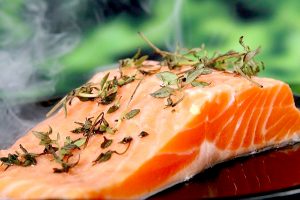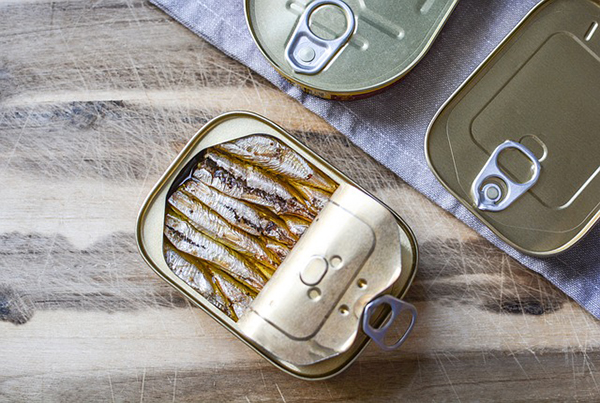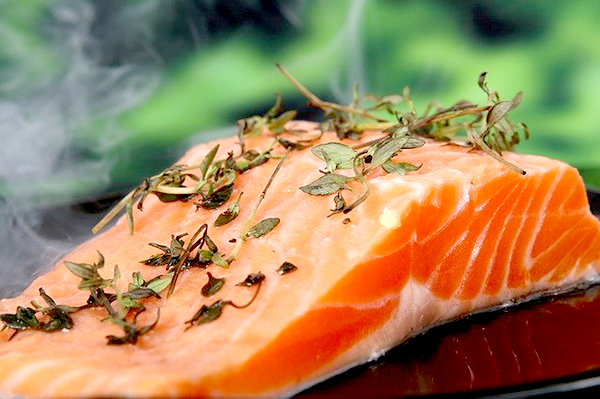Recipe: Good Mood Sardines
This dish will make even those who dislike sardines envious of your culinary talent. The mix of fresh herbs and lemon add freshness, while the sardines’ rich supply of omega-3 fatty acids helps lower inflammation in your body, including your heart and brain.
Video demo: Watch our registered dietitian Christy Goff demonstrates how to make this recipe.
Nutrition Corner: Omega-3 Fatty Acids
A Star for Your Health?
 Omega-3 fatty acids are a type of dietary fat that has been greatly studied over the years for its ability to improve health. This type of fatty acid is called an essential fatty acid because it is crucial for maintaining our heart and brain health and yet the body is unable to produce it. Therefore, we must ingest omega-3s from what we eat.
Omega-3 fatty acids are a type of dietary fat that has been greatly studied over the years for its ability to improve health. This type of fatty acid is called an essential fatty acid because it is crucial for maintaining our heart and brain health and yet the body is unable to produce it. Therefore, we must ingest omega-3s from what we eat.
There are three types of omega-3 fatty acids: eicosapentaenoic acid (EPA) and docosahexaenoic acid (DHA), which are both found in marine sources, including seaweed; and alpha-linolenic acid (ALA), which is found in plant sources like flax seeds. EPA is known for reducing inflammation in our body, which keeps our blood vessels and heart healthy. DHA plays an integral role in brain function, especially for the developing fetus and young children, by protecting cell membranes. Lastly, ALA is converted to EPA and DHA in the body; however, it is highly dependent on a person’s current health status, genetics, gender and general eating habits so you may need to eat more for the same results as EPA and DHA directly.
So, what is best? Studies show that eating two to three servings of marine animals high in omega-3s each week can help reduce a person’s risk for heart disease because of a reduction in triglycerides and blood pressure. Studies also show promise that regular omega-3 consumption is protective against cognitive decline and depressive disorders, although more research is needed on specific amounts.
The best sources include salmon, mackerel, sardines (see recipe), rainbow trout, herring, halibut, cod liver oil and anchovies. You also get some omega-3s from tuna, oysters, flax and chia seeds, walnuts and soybeans.
And how much? The National Institutes of Health suggests a range of amounts that depend on age and sex (see chart below). Because there isn’t one size that fits all, your provider or registered dietitian can suggest a dose that’s right for you, specifically if it involves supplementation.
Adequate intake measurements for omega-3s
| Age | Male | Female | Pregnant | Breast-feeding |
|---|---|---|---|---|
| Birth–6 months* | 0.5 g | 0.5 g | ||
| 7–12 months | 0.5 g | 0.5 g | ||
| 1–3 years** | 0.7 g | 0.7 g | ||
| 4–8 years** | 0.9 g | 0.9 g | ||
| 9–13 years** | 1.2 g | 1.0 g | ||
| 14–18 years** | 1.6 g | 1.1 g | 1.4 g | 1.3 g |
| 19–50 years** | 1.6 g | 1.1 g | 1.4 g | 1.3 g |
| 51+ years** | 1.6 g | 1.1 g |
g=grams *as total omega-3s **as ALA
Source: NIH
Click here for more information about our dietitian services. To make an appointment, use our appointment tool or call 206.505.1300.
Are You Struggling with Depression or SAD?
 Like other types of depression, seasonal affective disorder, or SAD, is a condition of the brain that leaves a person feeling down. It can sap your energy, erase your motivation and make you feel moody.
Like other types of depression, seasonal affective disorder, or SAD, is a condition of the brain that leaves a person feeling down. It can sap your energy, erase your motivation and make you feel moody.
SAD is cued by the low levels of light during winter’s shorter days. Its symptoms usually start in fall and end in spring. It can affect anyone, regardless of age, gender or health situation.
Ongoing depression is never a normal part of life. Read on to learn about the symptoms of depression and SAD, and how to seek treatment.
Signs and Symptoms
Signs and symptoms of depression and SAD may include:
- No longer enjoying the things you usually like to do.
- Feeling sad, down, hopeless or cranky most of the day, almost every day.
- Experiencing changes in your appetite or weight.
- Sleeping too much or too little.
- Feeling tired or having no energy.
- Feeling guilty or worthless.
- Having trouble concentrating.
- Feeling agitated.
- Thinking about death or suicide.
These symptoms are specific to SAD:
- Oversleeping
- Appetite changes, especially a craving for foods high in carbohydrates
- Weight gain
- Tiredness or low energy
(SAD sometimes occurs in people in spring and summer. Summer-onset SAD has nearly the opposite symptoms, including insomnia, poor appetite, weight loss and agitation.)
Treatment Options
Safe and effective treatments for depression and SAD are available. They can include seeing a psychotherapist, taking medications or a combination.
Additionally, with SAD, light therapy can be a powerful treatment protocol. With light therapy (also called phototherapy), you use a special light box “aka happy lights” and expose yourself right after you wake up each day. Doing this appears to trigger a change in your brain chemistry and boost your mood. It’s a bit like getting some summer sunshine to start the day. Light therapy often offers relief from SAD in just a few days.
With all types of depression, a behavioral health therapist or your primary care provider can guide you to the support you need. Make an appointment today.
Learn more about our Behavioral Medicine team at PacMed. Our team of licensed therapists offer individual, couples and family therapy. They also can help with medication management and provide psychiatric evaluation. To make an appointment, use our appointment tool or call 206.621.4045.
ARE YOU OR SOMEONE YOU KNOW IN CRISIS?
If you are thinking about suicide or hurting yourself, help is available:
- In an emergency, call 9-1-1
- Go to the emergency room at your local hospital
- Call the King County 24-Hour Crisis Line: 1 (866) 427-4747
- Call the National Suicide Prevention Lifeline: 1 (800) 273-8255
- Call your health care provider and tell them it is urgent
Heart-Healthy Resolution: Go Big, Go Positive
 Do you have high blood pressure or precursors to heart disease? This year, honor yourself and focus on good heart health. And your timing is perfect: February is National Heart Month!
Do you have high blood pressure or precursors to heart disease? This year, honor yourself and focus on good heart health. And your timing is perfect: February is National Heart Month!
Try our ideas to making a beneficial change in your heart health for 2018.
Go big—and SMART! Dream up your heart-healthy resolution. You’re aiming for a shift in focus, a new lens through which to view your lifestyle choices. Keep it SMART but flexible. The idea of SMART goals are that they have Specific, Measurable outcomes and are Attainable, Realistic and Timely. For example, the general goal of “I want to lower my blood pressure” becomes SMART when it expands to this: “By next month, I want to lower my blood pressure to less than 140/90 by increasing my exercise to 3 days per week and reducing my consumption of salty foods.”
Work with your doctor and dietitian. An excellent place to start for heart health is with your primary care provider or cardiologist, and a dietitian to sort out the details. Tell your provider that you are working on improved heart health in 2018. Ask what areas you might focus on for prevention or for treatment of a specific heart condition. Your provider can guide you in lifestyle changes to improve your heart health. The American Heart Association offers several guidelines for managing high blood pressure (also called hypertension)—eat a well-balanced, low-salt diet; quit smoking; enjoy regular physical activity; and more.
Stay positive with changes. When it comes to heart-smart eating in 2018, focus on your well-being, not the latest fad diet. One approach is to practice mindfulness as you eat. Take the time to check in with yourself: Am I really hungry? Which snacks give me good energy? Which foods make me feel good and inspire me to eat right? Once you’re sitting down to eat, slow down and appreciate the meal. Savor the colors … the flavors … the aroma. When you feel full, stop eating. Applying a positive attitude to your goal can be a rewarding path to success. It helps to lower stresses in your life and can assist you with feelings of failure.
If you have concerns about your heart health, our Cardiology department is available. To make an appointment, use our appointment tool or call 206.505.1300.
Seasonal Affective Disorder
Rene Czerwinski, from Pacific Medical Centers’ Totem Lake clinic, interviews with Q13 on Seasonal Affective Disorder (SAD). Rene practices behavioral medicine and is particularly interested in developing a safe space to help patients create and reach acceptance and fulfillment in life.
Seasonal Affective Disorder and Children
Dr. Gilmore was interviewed on Q13 about the Seasonal Affective Disorder & Children.
“Thank You” to the Living Well Alliance Family
 We wish to thank all the employees, organizations and community groups who invited the Living Well Alliance team to your worksite in 2017. With your help, we have continued to make great strides in our overarching goal of preventing chronic diseases in the Puget Sound area. We couldn’t have done it without your help and referrals. Thank you.
We wish to thank all the employees, organizations and community groups who invited the Living Well Alliance team to your worksite in 2017. With your help, we have continued to make great strides in our overarching goal of preventing chronic diseases in the Puget Sound area. We couldn’t have done it without your help and referrals. Thank you.
Some highlights! In 2017, the Living Well Alliance:
- Worked with 70 companies and community groups
- Conducted biometric screenings at 11 companies
- Made 80+ wellness presentations
- Supported 35 health fairs
- Offered new nutrition counseling through the national Enhance Wellness program
- Held our second annual Wellness Symposium for area HR professionals to share, learn and grow their company’s wellness offerings
For more information about our programs and current classes, visit our website or email LivingWellAlliance@pacmed.org. Share any feedback with us as well! We appreciate your thoughts.
The Living Well Alliance is run by Pacific Medical Centers. Call us today at 206.621.4419.
Recipe: Revitalizing Spice Tea
This revitalizing tea is a unique blend of warming herbs that have invigorating properties while leaving the house smelling great while you cook it. Ginger helps improve digestion and reduce nausea, while cinnamon improves circulation and may comfort coughs. Cardamom helps aid digestion, and peppermint freshens the breath.
Give Back and Build Strong Communities
 Giving back to those around you is a wonderful way to build community. Donating your time or providing supplies to those in need can also remind us of the power of doing good, sharing life’s burdens and spreading joy. It can also be a low-cost and powerful antidote to the pressures of consumerism.
Giving back to those around you is a wonderful way to build community. Donating your time or providing supplies to those in need can also remind us of the power of doing good, sharing life’s burdens and spreading joy. It can also be a low-cost and powerful antidote to the pressures of consumerism.
Our local communities need your gifts of creativity, energy, support and caring. Make it a team effort! Pull together family and friends and pick a project, big or small.
Shop (or sew or craft!) for patients at Seattle Children’s hospital.
Your thoughtful gift helps young patients and their families when they need it most.The Toy & Items for Patients web page gives all the details. Can you sew a flannel blanket for an infant? Want to shop for preteens? Look for links under the “Our Greatest Needs” section. The web page also gives details about wrapping (don’t!), donation drop-off, and other ways to give. Short on time?
Help your children learn the joys of giving, with Toys for Tots.
This is a wonderful way to teach generosity and help children get involved. Run by the US Marine Corp Reserve, Toys for Tots has several ways to donate toys. They ask for new, unwrapped toys and get them to families who can’t afford gifts. Find a local program or check out the Toys for Tots Native American Program.
Support youth in foster care—academic resources, clothing extracurricular fun.
Treehouse provides academic and other essential support for 7,000+foster kids throughout Washington State each year. Besides investing in their academic future, Treehouse helps them try to fit in and feel comfortable with clothing that suits them and resources to take part in extracurricular activities. You can donate time, money, supplies or host a drive – see the Take Action page!
Collect donations for a food bank—or help sort, label and prep food!
Food banks distribute food to people in need. Make it a group activity with family or friends. Either donate time on an afternoon, or do a group shopping and donate needed food. Check the food bank’s website for acceptable, needed items—including non-food items. Sample items include packaged whole-grain foods, canned vegetables, low-sodium broth and low-sodium canned meats or fish.
Search an online map for “food bank” and give them a call. Or try one of these:
Food Lifeline (numerous sponsored food banks throughout Puget Sound region) • Nourish Pierce County (formerly FISH Food Banks) • Kent Food Bank • Rainer Valley Food Bank • North Helpline (NE Seattle) • HopeLink (Eastside, Shoreline, Sno-Valley) • Lynnwood Food Bank • Mill Creek Food Bank
Thanks for sharing your energy and joy with others! Knowing you are giving helpful and even fun gifts to those who need them most can be very fulfilling.
A Healthy Approach to the Holidays
Scrumptious treats. Rich meals. Special beverages. Plus, parents, siblings, neighbors and friends! For many, the joys of the holidays are a source of stress … and weight gain. With some thoughtful planning and attitude adjustment, you can keep stress to a minimum—and maintain your weight come January!
- Keep your appetite in check. With a sumptuous dinner party ahead, it’s tempting to skip meals or eat less before you go. Instead, eat as you typically do, so you arrive at the festivities with your usual appetite. Then, munch on a plate of vegetables or salad as an appetizer. Vegetables are low in calories, and filling up on them at the beginning of a meal will keep you from overdoing it with higher-calorie options later on.
- Limit yourself to one plate with small portions. This will still allow you to get a taste of everything while not overdoing it. It takes about 20 minutes for our stomachs to realize we’re full, so wait at least 20 minutes after your first plate before deciding if you want seconds.
- Are desserts your nemesis? Love salty snacks? If you know the desserts will be calling your name, make a deal with yourself before the event to have just your favorite one. If salty snacks are your Achilles’ heel, choose to skip any chips or crackers. These snacks are available throughout the year—so why waste calories on them when there are bacon-wrapped scallops to be eaten!
Our outlook and expectations may have as much to do with how we manage the holidays as our resources. As you get into the full swing of the holidays, try these three stress-busters:
- Think about your expectations. Be honest about what you want, and be realistic about what is possible. Then, try these two rules: Keep it simple. Don’t over-commit. If you need to, scale back your plans. Remember, you’re not Superman or Superwoman.
- Accept people as they are. Don’t expect others to behave as you would like them to. This is a recipe for disappointment, if not misery. Recognize that the people in your life will celebrate the holidays as they want to and not the way you want them to. So don’t try to change or control them.
- Remember, even the best-laid plans can go awry. This goes back to expectations. Expect that some problems are possible or even likely—inclement weather, delayed guests, an overcooked dinner. Try to approach unexpected challenges with an open mind, patience, creativity or a sense of humor.
A final idea, for both stress and healthy eating: get everyone outdoors, walking, jumping puddles or kicking a ball around. Exercise is good for your emotional state and your waistline! Remember, the holidays are short, as is life. Make the most of them!
The dietitians at PacMed help patients support good health through better eating habits. The PacMed behavioral medicine team offers a variety of therapy to help patients cope with a wide range of problems.










